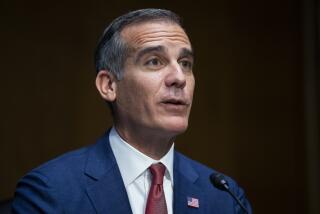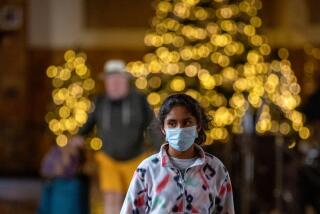Amid a crisis, Mayor Garcetti talks to L.A. each night about distancing, masks and love
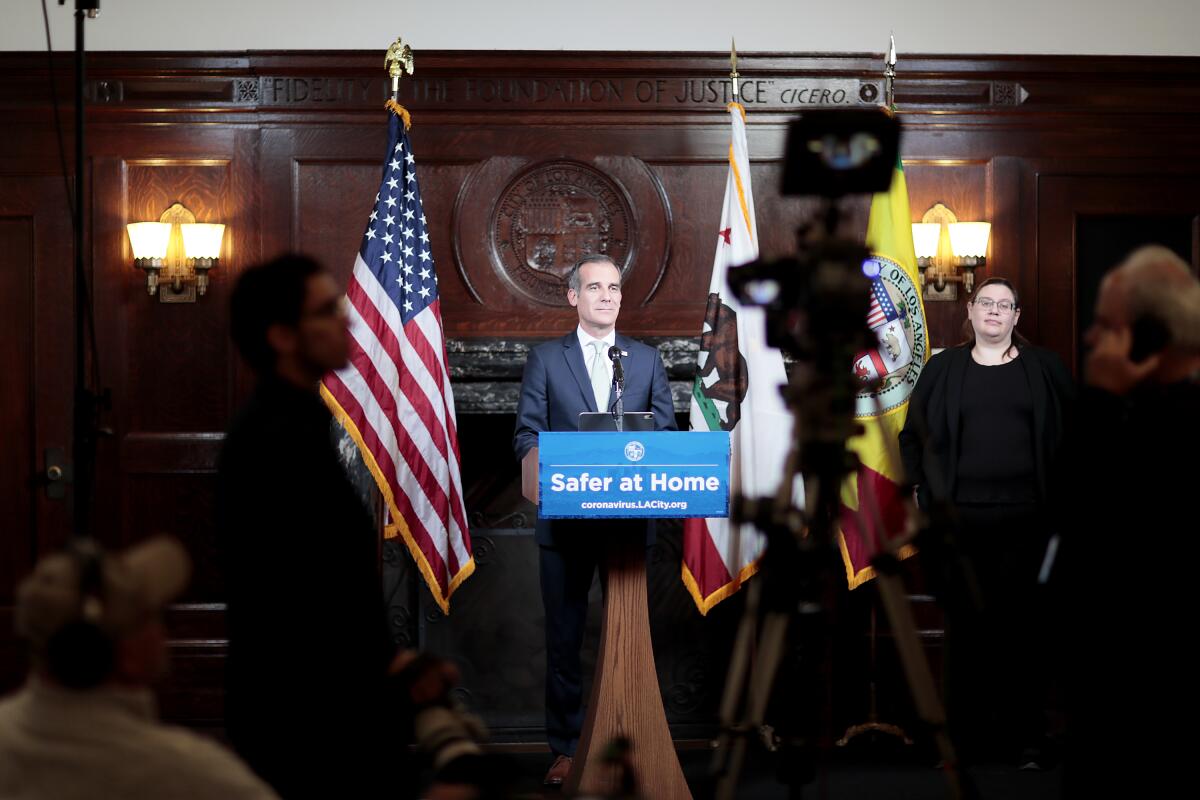
It was the first day of April and Los Angeles Mayor Eric Garcetti was on live television once again, standing before a single camera in a nearly empty City Hall.
Over the previous 2½ weeks, the 49-year-old mayor had cheered viewers on for staying home, scolded them for crowding beaches and trails, and admonished them to stop hoarding food and other supplies.
On this particular evening, he was trying to accomplish a more complicated task: Get Angelenos comfortable with the idea of wearing cloth face masks.
“We’re gonna have to get used to, you know, seeing each other like this,” said the mayor, fumbling to get the mask to go where it was supposed to.
Then, mask fully on, he declared: “This will be the look!”
At least five nights a week, Garcetti has appealed directly to Angelenos on live television — or Facebook, for those with smaller screens — to get them to comply with public health orders and keep up with the region’s rapidly changing response to the spread of the novel coronavirus.
In his briefings, he has struck a tone that is one part stern dad, one part life coach, with a hint of Marianne Williamson, the self-help guru. He has told viewers he believes in them. He has counseled them to reconnect with old friends. At one point last month, he advised them to call their mothers.

The nightly briefings are part of a nationwide phenomenon of elected officials who, because of their need to get information out quickly, are connecting with their constituents in new and more immediate ways.
In some sections of the country, the televised coronavirus sessions have made viewers see their politicians in a new light. In others, they have served as therapeutic happy hours for an anxious public.
In the Midwest, Ohio Gov. Mike DeWine’s afternoon TV briefings have come to be known as “Wine with DeWine.” In Kentucky, updates from Gov. Andy Beshear have been coined “Beers with Beshear.” In New York, locked in a grim fight against the virus, viewers have voiced new appreciation for the blunt stylings of Gov. Andrew Cuomo.
On the West Coast, Garcetti has been communicating in ways that “come from a place of love,” said Loyola Law School professor Jessica Levinson, an observer of local and national politics. Those messages are in keeping with the mayor’s public persona, she said.
“He’s tried to come from a place of kindness. He’s trying to build consensus,” she said.
***
Love does indeed come up a lot.
During his evening briefings, Garcetti has described the decision to stay indoors as an act of #LALove. He has urged viewers to reach out to their neighbors and “lead with love.” He ends his addresses with the phrase “Strength and love, Los Angeles” — “Fuerza y amor” for Spanish-language viewers.

Garcetti has advised viewers to put down their cellphones and take a break from news alerts. And he has discussed the emotional toll that can come from isolating at home, particularly for those who live alone.
“If you’re depressed or feeling down, determine what can you do tonight to feel strong again,” he said on Day 4.
The briefings have provided comfort to Pauline Mauro, a 49-year-old financial research coordinator holed up with her family in their Eagle Rock home.
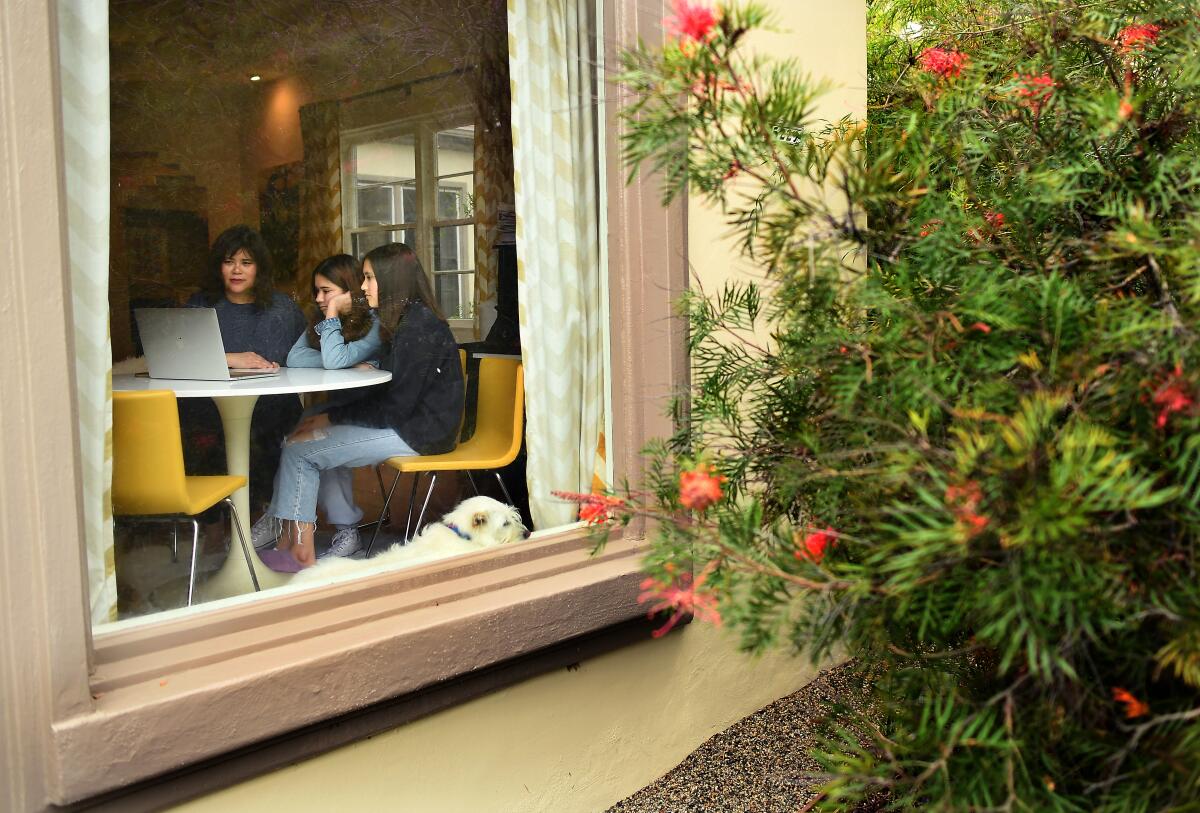
Mauro, who has been watching the briefings on her laptop, praised the mayor for delivering an inclusive message — he highlights the needs of immigrants and gives extended remarks in Spanish — and for showing the city he cares about its residents.
“He’s calm, and that makes me calm,” she said.
In an interview, Garcetti acknowledged that his briefings have hit on more personal themes, particularly love and looking out for one’s neighbor. Those types of conversations will be essential, he said, for the city to weather the crisis.
“There’s a lot of pain out there,” he said. “There’s a lot of pre-mourning and, already for some families, mourning of loss. And I think if you’re not honest about that, you’re not going to get through this.”
***
So far, the mayor’s evening briefings have had an extraordinarily broad reach. On Tuesday, when he ordered shoppers to begin wearing face coverings at supermarkets and elsewhere, his remarks were aired live on at least eight television stations.
Garcetti said he sees the addresses as part of his job as “storyteller in chief,” encouraging people to do more, make more sacrifices, than they might have otherwise.
“I really think that narratives move numbers,” he said. “When we understand why we’re doing things and what’s happening, you can have people stretch much further than they ever think they can.”

In Northridge, plant supervisor Favio Reveles said he’s come to appreciate the mayor’s appearances, which he watches on his cellphone while sitting in his backyard.
“He makes it seem like everyone is in it together,” the 33-year-old said.
Tali Sigalus, who manages an apartment building in Palms, had a much more negative reaction. Sigalus said she had hoped Garcetti would tell viewers he’s working to ensure rents and mortgages are completely forgiven in L.A. during the shutdown.
“He’s coming off as compassionate and sympathetic,” she said. “But real compassion would be understanding the economic ramifications of this crisis.”
Asked about such criticism, Garcetti said he well understands “how deeply Angelenos are hurting right now” — and is talking to lawmakers in Washington, D.C., about sweeping federal relief for tenants, landlords and others. On a recent Reddit Q&A, he also said the city would quickly go bankrupt if it had to cover everyone’s rent.
***
Garcetti’s first live TV address on the coronavirus took place on March 15 and was, in many ways, a bombshell. In an emergency order, he called for the shutdown of businesses close to the hearts of Angelenos.

In an industry town, movie theaters would be shut down. For a food-obsessed populace, restaurants would serve takeout or delivery — or nothing at all. Garcetti tightened the screws over the following days, closing shopping malls, hiking trails, beach parking lots, even a grassy expanse in Silver Lake popular with families.
On Day 11, he warned viewers to expect at least two months indoors. And on Day 20, Garcetti acknowledged his own fears about the coming days.
“In my experience in government, this is by far the most intense thing that I have ever gone through,” he told viewers.
***
Garcetti has also used his TV briefings to tell viewers about city programs aimed at slowing the virus’ spread among the city’s neediest. But in some cases, those efforts have fallen far short of what he announced.
In mid-March, he said the city would set up 6,000 beds for homeless residents in closed recreation centers, reducing the threat of the virus to those on the streets. That effort has had a very slow start, and last week, a high-level Garcetti aide confirmed the goal is now closer to 2,000 beds.
The mayor also told viewers that outdoor hand-washing stations would ensure improved hygiene among the homeless population. A federal judge recently visited some of those stations and found that many don’t have water.
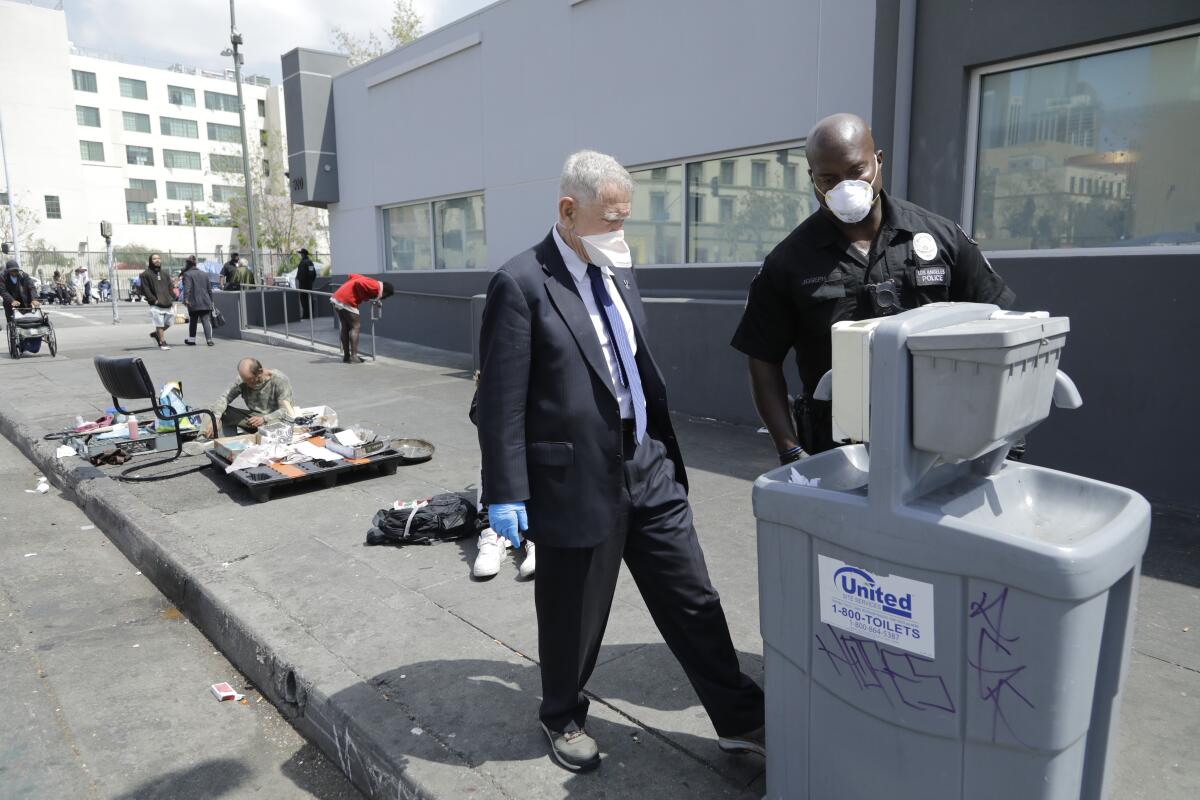
“The things that he says, and what’s actually happening on the ground, is always night and day,” said Pete White, who heads the Los Angeles Community Action Network, a downtown-based antipoverty group.
Garcetti told viewers last week that L.A. is ramping up maintenance of hand-washing stations. He also said the city had to lower its goals for the homeless shelters to comply with public health requirements for social distancing.
***
By the end of their fourth week, Garcetti’s briefings had fallen into a familiar rhythm. He gave the newest number of cases and the latest number of deaths. He continued urging the city to stay inside.
“Now is the time not to let up,” he said.
Times staff writer Benjamin Oreskes contributed to this report.
More to Read
Start your day right
Sign up for Essential California for news, features and recommendations from the L.A. Times and beyond in your inbox six days a week.
You may occasionally receive promotional content from the Los Angeles Times.
